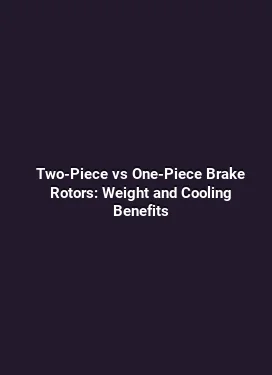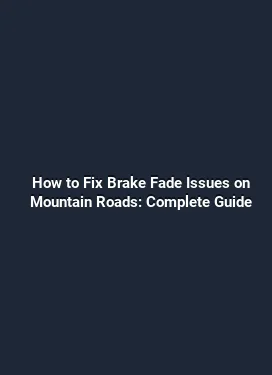Steel Braided Brake Lines Installation Guide for Better Brake Feel
Understanding the Benefits and Why Upgrading Matters

Upgrading to steel braided brake lines is a popular modification among enthusiasts aiming to improve pedal feel, response, and overall braking consistency. Unlike conventional rubber lines, steel braided lines with a reinforced outer layer resist expansion under pressure. This translates into a firmer, more immediate brake pedal, reduced pedal travel, and improved modulation during aggressive braking or track sessions. The underlying science combines fluid dynamics, hose elasticity, and heat management. When braking forces rise, conventional hoses can flatten slightly, allowing fluid to compress and the pedal to sink. Steel braided lines minimize this stretch, maintaining a more stable hydraulic connection from the master cylinder to each caliper.
Key advantages include enhanced pedal rigidity, reduced sponginess after repeated stops, improved brake feel under high loads, and better predictability when using performance fluid or upgraded calipers. It is important to note that this upgrade does not inherently increase stopping power; rather, it improves how that power is transmitted and perceived by the driver. For a well-rounded upgrade, consider complementary improvements such as higher quality brake fluid, caliper choices, and rotor surfaces that can exploit the steadier line pressure.
Pre-Installation Considerations and Planning
Before removing stock lines, inventory the exact components required and verify compatibility with vehicle make, model, and year. Steel braided lines come in various end fittings (banjo bolts, metric banjo, and straight fittings) and thread pitches. Mismatched fittings can lead to leaks, cross-threading, or alignment issues that compromise braking performance. Consulting the vehicle manual or manufacturer specifications is a prudent starting point, but it is also common to need a custom hose length to avoid excessive slack or kinking while steering or suspension travel changes under load.
One practical planning step is to map the routing path of the lines. Ensuring clean, unobstructed routes helps prevent chafing with wheel wells, suspension components, or moving brake hardware during dynamic driving. A high-quality line with protective sleeving or abrasion-resistant coatings will endure heat, road debris, and repeated flexing without compromising integrity. When selecting lines, focus on hose material quality, braid density, and end-fittings inclusivity, as these factors determine reliability over years of driving exposure.
Tools, Materials, and Safety Considerations

Tools include a set of metric and standard wrenches, flare nut wrenches for brake fittings, torque wrench for precise fastener tightening, brake line alignment tool or pliers with soft jaws, and a catch tray to manage old fluid. A line uncoiling tool or clean workspace helps prevent kinking during installation. For bleeding, gather a clear plastic container, brake fluid compatible with your system, a suitable syringe or one-man bleeder kit, and clamps or hose guides to control fluid flow.
Materials consist of steel braided brake lines with correct end fittings, new washers or crush rings if required by the fittings, and fresh brake fluid of the recommended type (DOT specification per vehicle). It is common to replace any worn banjo bolts and seals during installation to ensure a leak-free connection. Consider purchasing protective heat sleeves for exposed portions of lines that traverse near exhaust components or high-heat zones in the engine bay.
Safety is critical. Work on a flat, stable surface; engage wheel chocks; ensure the vehicle is securely supported on jack stands if needed. Do not rely on a jack alone to support the vehicle. Brake system components operate under significant hydraulic pressure and can injure if mis-handled. When draining or bleeding fluid, work slowly to minimize air ingestion, and dispose of old brake fluid in accordance with local regulations because it is a hazardous waste.
Disassembly: Removing Stock Lines and Preparing the System
Start by lifting the vehicle and allowing access to the brake line connections at the master cylinder and each caliper or wheel cylinder as applicable. Carefully detach the old rubber lines, noting the orientation of each line to ensure correct reassembly. If your vehicle uses a brake proportioning valve or anti-lock braking system (ABS) sensors, document their routing and connections to avoid triggering fault codes or air entrapment during bleeding.
As you remove lines, inspect the surrounding components for wear or damage. Look for corroded fittings, rusted hard lines, or damaged banjo bolts. Replace any suspect hardware before installing new lines. Clean the mounting surfaces to ensure a clean seal for new fittings. If you discover compromised hard lines or corrosion in the caliper mounting points, address these issues before proceeding, as they can undermine the reliability of the entire system.
Fitting Alignment and Routing best practices
Align each steel braided line along an unobstructed path that avoids sharp bends and tight radii. Excessive bending can crease the braid, reducing its effectiveness or causing premature wear. Use clamps or guides that do not pinch the line and avoid routing lines through moving suspension components or near sharp edges. Ensure the braid does not contact exhaust heat shields or hot pipes where thermal exposure could degrade the outer coating over time.
Installation: Connecting Steel Braided Lines
With the vehicle safely supported and old lines removed, begin attaching the new steel braided lines. Start at the master cylinder or the line from the brake fluid reservoir, proceeding outward to each caliper. Apply a thin layer of thread sealant only where specified by the line manufacturer and never on the sealing faces themselves. If crush washers or sealing flanges accompany the fittings, install them according to the product instructions to achieve a proper seal.
Gradually tighten the fittings to the manufacturer’s specified torque. It is essential to use a torque wrench to achieve a consistent clamping force, preventing leaks or line slippage under braking loads. After securing all connections, carefully inspect each joint for potential gaps or misalignment. A misaligned line can rub against the wheel, producing noise or wear over time.
During installation, consider temporary fluid management strategies. If you need to drain or evacuate fluid for line replacement, avoid letting air enter the system. A two-person bleed process or a one-man bleeding technique using a bleed bottle can expedite air removal and reduce the risk of introducing air into the system.
Bleeding and Flushing: Achieving a Firm Pedal
Bleeding is a critical step to restore firm pedal feel after line installation. Begin by bleeding at the wheel farthest from the master cylinder and proceed in a diagonal pattern toward the closest wheel. This approach helps remove trapped air efficiently. Use a transparent reservoir to monitor the clarity of the fluid and the avoidance of air pockets. When bleeding, ensure the master cylinder remains topped to prevent drawing in air from the reservoir.
During bleeding, watch for a consistent, bubble-free stream. If air pockets persist, consider performing a short, controlled pump-and-hold sequence to coax residual air into the reservoir. Recheck fluid level after each wheel is bled and top up as necessary. A quality brake fluid with good humidity resistance helps maintain consistent performance across temperature variations and repeated stops.
Torque Specs, Validation, and Fine-Tuning
Torque specification for brake line fittings varies by vehicle and line design. Always consult the line manufacturer’s documentation for precise values. In many cases, fittings are tightened to a modest range that ensures an adequate seal without over-torquing sensitive components. Use a calibrated torque wrench and verify that both the line and mounting hardware are secure without overtightening. After initial driving, recheck all fittings for tightness, as heat cycles can cause minor changes in clamping force.
To validate improved brake feel, perform controlled tests on a safe, closed environment. Begin with light braking to gauge pedal firmness, then progress to moderate and light deceleration to evaluate modulation. Compare pedal travel before and after the upgrade to quantify the improvement in predictability. During these tests, monitor for any abnormal noises, vibrations, or fluid loss that could indicate issues with routing, clearance, or seals.
Maintenance, Inspection, and Longevity Outlook
Steel braided lines require periodic inspection just like factory lines. Check for superficial abrasion, braided wear at initiation points, and any staining or seepage at the fittings. While steel braids are designed for durability, the ends can be points of vulnerability if not properly installed or if supported lines rub against harsh edges. Replace any lines showing visible wear, cracking, or deformation in the braid or seal areas. If the vehicle is driven in harsh environmental conditions—sand, salted roads, or aggressive track use—inspect lines more frequently and consider proactive replacements before wear becomes a problem.
Performance-minded drivers often pair steel braided lines with high-quality brake fluid and upgraded rotor surfaces to maximize the perceived improvement in pedal feel. Rotors with improved metallurgy and more even surface finishes contribute to consistent bite and fade resistance, which complements the steadier hydraulic connection provided by the braided lines. Regular brake fluid replacement intervals help prevent moisture buildup and maintain stable boiling points under heavy use, further supporting a firm, predictable brake pedal.
Common Pitfalls and Troubleshooting
Several issues can arise if installation is rushed or components are mismatched. Leaks at the fittings indicate insufficient torque, incompatible washers, or damaged sealing faces. A spongey pedal immediately after installation can signal air still present in the system or air trapped in ABS modules if the vehicle uses an anti-lock system. In some cases, improper routing leads to line contact with suspension components, which can generate noise or physical wear. If pedal feel remains soft after bleeding and inspection, a professional brake bleed using proper equipment may be necessary to remove stubborn air pockets from the ABS module and caliper circuits.
To prevent future problems, create a simple maintenance checklist: examine lines for kinks or chafing, confirm mounting and routing clearance, verify torque at all fittings, monitor fluid color and level, and conduct periodic road tests in controlled environments to confirm consistent pedal feel. These steps help ensure the upgrade continues to deliver the intended performance benefits over time.
Integrating with Other Upgrades and Driving Scenarios
Steel braided lines pair well with brake fluid upgrades, high-performance rotors, and caliper enhancements to deliver a cohesive braking system. For street use, ensure compatibility with daily driving conditions and service limitations. For track or spirited driving, the combination of stiffer lines and better fluid resilience reduces pedal travel under repeated stops, allowing the driver to apply more precise braking inputs and maintain confidence during aggressive braking zones.
In high-temperature environments, verify that line routing minimizes heat exposure and that protective shielding is installed where needed. Maintaining cool operating temperatures in the braking system helps prevent brake fade and ensures the consistent pedal feel drivers expect during demanding sessions.
Final Thoughts: Achieving Consistent Braking Performance
Upgrading to steel braided brake lines is a meaningful step toward a more linear and predictable braking experience. By paying attention to compatibility, routing, secure fittings, and maintenance, drivers can realize a more confident pedal feel that translates into improved control on both roads and tracks. The process emphasizes careful preparation, precise installation, and disciplined maintenance, all of which contribute to a braking system that remains responsive under a wide range of conditions.






